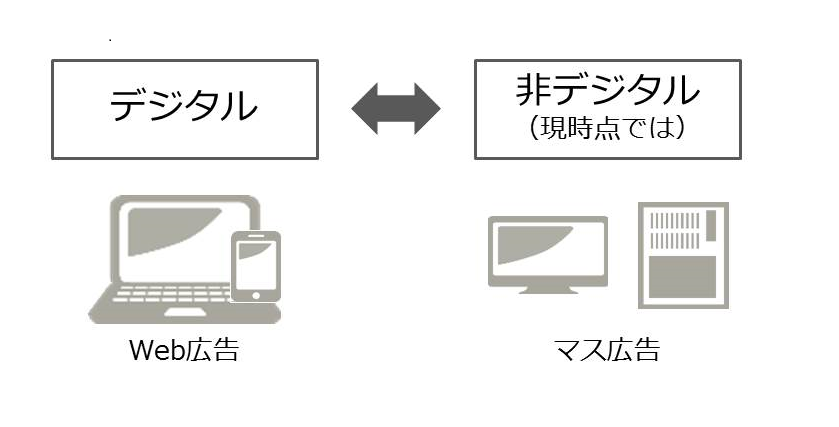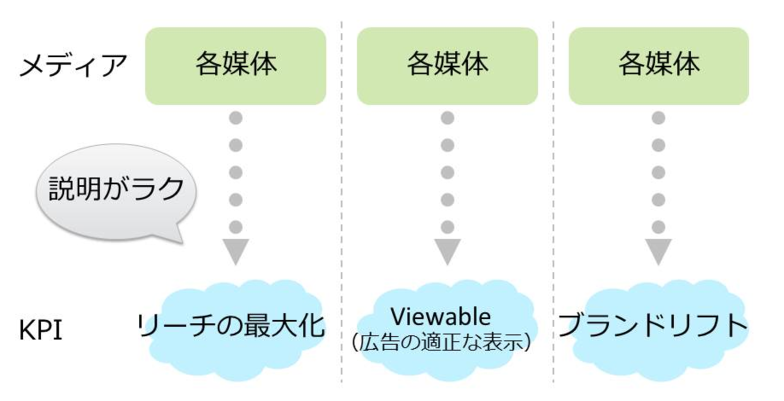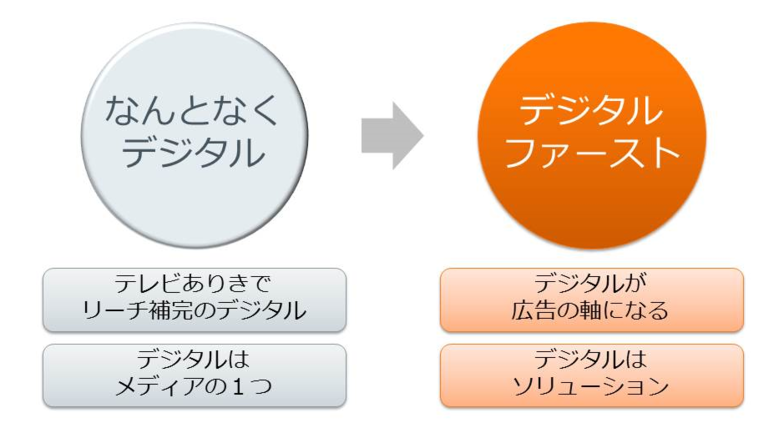Note: This website was automatically translated, so some terms or nuances may not be completely accurate.
Lesson 4: Integrating Mass Media Advertising and Digital Advertising
This session reviews Lesson 4, "Integrating Mass Advertising and Digital Advertising," from the " Dentsu Inc. Style Digital Marketing " course currently available on the online video learning service schoo WEB-campus, and revisits questions raised during the lecture.
The theme of this course was to revisit the fundamentals for designing digital marketing as a whole by clarifying what digital transformation truly means, starting from the perspective of media—an accessible entry point to digital marketing. So, let's begin by considering the fundamental question: What is digital, anyway?
What exactly is "digital"?
While digital advertising is often equated with web advertising, we deliberately want to delve deeper into this distinction.
From a media perspective, we can categorize it as web advertising using digital media versus mass advertising using (currently) non-digital media.

So, what does digitalization in media fundamentally refer to?
I believe this can be organized by the difference between broadcasting and communications.
Broadcasting involved information flowing "one-to-many (mass)" from a central station to individual receivers, and this flow was "unidirectional." Consequently, advertising formats were constrained by this characteristic: ads in the same TV program or newspaper page were identical for everyone, and because it was unidirectional communication, the effectiveness of ads after they aired was fundamentally impossible to measure.
Communication, on the other hand, allows each terminal to freely access information and select and obtain the information they desire. This means information acquisition is possible on a "one-to-one" basis per user. Furthermore, the ability to select and obtain desired information means the flow of information is not one-way but "two-way." Consequently, regarding advertising formats, even within the same ad space on a site, different ads can be displayed to each individual user. Additionally, because it is two-way, a significant amount of information regarding advertising effectiveness can now be measured.
This difference between "broadcasting" and "communication" represents a significant paradigm shift in advertising. With broadcasting—that is, (current) mass media—no matter how much marketing research was conducted or how detailed the target audience hypotheses were, the final media planning stage could only reach targets at a granularity like "primarily F1 demographic." Digital media, however, can reproduce the initially designed target audience hypotheses and specifications with considerable precision.
However, the current state of web advertising does not necessarily leverage this fundamental value of digital.
Common Pitfalls in Mass-Digital Integration
Mass advertising, while offering large reach, struggles with detailed design, whereas digital advertising excels at granular design. Therefore, the true form of mass-digital integration should leverage this characteristic to enable detailed communication design tailored to each target group – something mass media alone couldn't achieve.
Yet, current mass-digital integration often remains confined to the context of reach supplementation for mass media, thinking along the lines of "It seems more young people aren't watching TV, so maybe we should try online alongside mass media." In other words, mass media remains the primary focus.
But think about it. When we talk about reach supplementation, what does "We reached 50,000 people!" really mean? On its own, it tells us absolutely nothing about "what kind of users were reached" or "what level of attitude change effect was achieved." In the broadcast era, detailed metrics weren't available. Even if they were, the next steps were limited to coarse adjustments like changing the program offered, and results were judged simply by looking at reach. Despite the digital era bringing visibility to metrics like the attributes of reached users (interests, estimated gender/age) and differences in attitude change, continuing to use only the same yardstick as the broadcast era is a tremendous waste.
The fact that we've only ever talked about "points" like reach is also the responsibility of advertising agencies, who sell the ads. The strengths of digital – "one-to-one = highly customizable design" and "interactivity = visible effectiveness" – also mean that design becomes incredibly tedious. If we could get away with just talking about reach as a "point," it's hard to deny there wasn't a certain complacency about not wanting to bother with the difficult stuff.
Furthermore, web advertising has traditionally served many direct-response clients (like e-commerce, where sales are directly linked), making the cost per acquisition (CPA) for actions like inquiries or purchases the primary performance metric, rather than views or clicks. CPA is the quintessential point-based metric. Under the sound logic that a good CPA is good for the client's business, the mainstream approach became solely focused on improving CPA.
However, many clients have goals beyond short-term outcomes like online purchases or sign-ups. When such clients consider web advertising, it's undeniably dishonest to discuss it solely through overly simplified metrics like CPA or cost per reach.

The fundamental premise of true mass-digital integration is abandoning the complacency that simplistic "point" metrics like CPA, CPC, reach, or view rates can tell the whole story, and instead embracing communication design as a "surface."
The True Concept of Mass-Digital Integration
Of course, the results of this holistic design cannot be encapsulated in abstract terms like "branding." Phrases like "there was some branding effect" are precisely what I detest most, having worked with direct-response clients for years and constantly grappled with CPA.
Our goal is to consistently engage with outcomes that are quantitatively measurable, without oversimplifying the metrics.
For this, media selection alone is insufficient. To design the whole as a "surface," it is absolutely essential to appropriately assemble all elements: media, of course, but also "what to communicate," "who to communicate it to," and "how to evaluate it."
While various approaches exist, let's consider one starting from the target audience.
For example, if the product were a credit card, traditional web advertising approaches offered only two options: either supplementing TV commercial reach (for awareness) or a direct approach (harvesting) targeting people actively searching for credit cards.
However, if we think a bit more broadly about the target audience, we can identify broader interests like "people who love travel" or "people who enjoy high-end restaurants."
One approach is to consider these peripheral areas around the product itself. The key point here is not to stop at simply placing ads on travel-related media because the target audience likes travel. Beyond media selection, effectively placing content on the ad creative and the landing page after a click that explains "how a credit card can be useful from a travel perspective" can significantly enhance the attitude change effect.
As we've seen, designing a strategy that targets those in the middle—neither purely awareness nor conversion—is essential for creating new product demand through attitude change. And the medium best suited for this demand creation is digital, which can appeal to travel enthusiasts or fine dining lovers through approaches tailored to each.
The Future of Mass-Digital Integration
If we call the era where digital media was treated as just another medium alongside TV, etc., the "vaguely digital" era, then the era where digital media is used as a solution capable of designing various elements like target, media, message, and KPI for new demand creation can be called the "digital-first" era.

Currently, only web advertising is digital, but digitalization will advance into other media and advertising formats. The convergence of broadcasting and telecommunications has long been discussed, and the emergence of VOD services like Netflix and Hulu has indeed brought TV content onto telecommunications networks. Digital signage and the digitization of OOH (Out-of-Home) advertising are other examples.
To avoid being left behind by this wave of digitization, we aim to further refine our digital methodology as an essential solution.
The 'Dentsu Inc. Digital Marketing ' course is scheduled for six lectures on the dates below. The live broadcasts on the recording days are free, so don't miss them.
Session 1: Getting Started with Digital Marketing: Masafumi Tanizawa
May 27 (Fri) - Completed, recorded lecture now available
Lecture 2: Content Marketing for Digital Marketing: Akiko Gunji
June 24 (Fri) - Completed, recorded lecture available
Lecture 3: Digital Advertising Course to Avoid Technology Frustration: Koichiro Kondo
July 22 (Fri) - Completed, recorded lecture available
4th Period: Integrating Mass Advertising and Digital Advertising: Sohei Mitani
August 26 (Fri) - Completed, recorded lecture available
Session 5: Marketing Systems Linking Customer Experience to Business Growth: Katsumasa Yagi
September 23 (Fri) 19:15〜
6th Period: Enriching Innovation Ideation Through Digital: Masafumi Tanizawa
Friday, October 28, 19:15~
Next up on Friday, September 23: "Marketing Systems that Connect Customer Experience to Business Growth" by Katsuzo Yagi of Dentsu Digital Inc. Be sure to watch.
Was this article helpful?
Newsletter registration is here
We select and publish important news every day
For inquiries about this article
Back Numbers
Author

Sohei Mitani
Dentsu Inc.
Data & Technology Center Platformer Data Division 2
Drawing on experience improving ROI for direct-response advertisers, I pioneered numerous cases of developing new methodologies that quantify branding through measurable "performance" metrics using ad technology. I led the proposal and adoption of solutions like the True Lift Model for evaluating net advertising lift and X-Stack for maximizing direct business outcomes.
